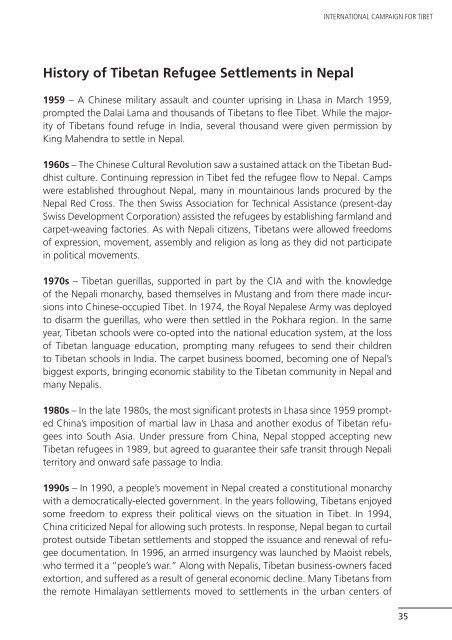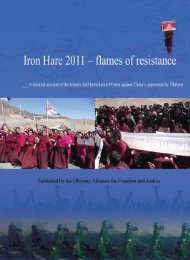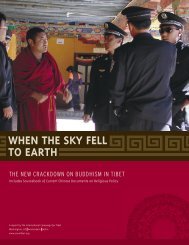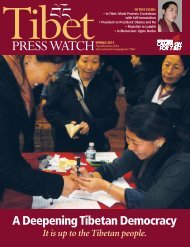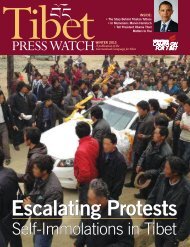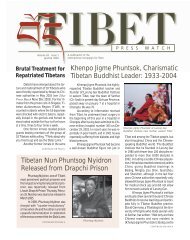DANGEROUS CROSSING: - International Campaign for Tibet
DANGEROUS CROSSING: - International Campaign for Tibet
DANGEROUS CROSSING: - International Campaign for Tibet
You also want an ePaper? Increase the reach of your titles
YUMPU automatically turns print PDFs into web optimized ePapers that Google loves.
INTERNATIONAL CAMPAIGN FOR TIBET<br />
1959 – A Chinese military assault and counter uprising in Lhasa in March 1959,<br />
prompted the Dalai Lama and thousands of <strong>Tibet</strong>ans to flee <strong>Tibet</strong>. While the majority<br />
of <strong>Tibet</strong>ans found refuge in India, several thousand were given permission by<br />
King Mahendra to settle in Nepal.<br />
1960s – The Chinese Cultural Revolution saw a sustained attack on the <strong>Tibet</strong>an Buddhist<br />
culture. Continuing repression in <strong>Tibet</strong> fed the refugee flow to Nepal. Camps<br />
were established throughout Nepal, many in mountainous lands procured by the<br />
Nepal Red Cross. The then Swiss Association <strong>for</strong> Technical Assistance (present-day<br />
Swiss Development Corporation) assisted the refugees by establishing farmland and<br />
carpet-weaving factories. As with Nepali citizens, <strong>Tibet</strong>ans were allowed freedoms<br />
of expression, movement, assembly and religion as long as they did not participate<br />
in political movements.<br />
1970s – <strong>Tibet</strong>an guerillas, supported in part by the CIA and with the knowledge<br />
of the Nepali monarchy, based themselves in Mustang and from there made incursions<br />
into Chinese-occupied <strong>Tibet</strong>. In 1974, the Royal Nepalese Army was deployed<br />
to disarm the guerillas, who were then settled in the Pokhara region. In the same<br />
year, <strong>Tibet</strong>an schools were co-opted into the national education system, at the loss<br />
of <strong>Tibet</strong>an language education, prompting many refugees to send their children<br />
to <strong>Tibet</strong>an schools in India. The carpet business boomed, becoming one of Nepal’s<br />
biggest exports, bringing economic stability to the <strong>Tibet</strong>an community in Nepal and<br />
many Nepalis.<br />
1980s – In the late 1980s, the most significant protests in Lhasa since 1959 prompted<br />
China’s imposition of martial law in Lhasa and another exodus of <strong>Tibet</strong>an refugees<br />
into South Asia. Under pressure from China, Nepal stopped accepting new<br />
<strong>Tibet</strong>an refugees in 1989, but agreed to guarantee their safe transit through Nepali<br />
territory and onward safe passage to India.<br />
1990s – In 1990, a people’s movement in Nepal created a constitutional monarchy<br />
with a democratically-elected government. In the years following, <strong>Tibet</strong>ans enjoyed<br />
some freedom to express their political views on the situation in <strong>Tibet</strong>. In 1994,<br />
China criticized Nepal <strong>for</strong> allowing such protests. In response, Nepal began to curtail<br />
protest outside <strong>Tibet</strong>an settlements and stopped the issuance and renewal of refugee<br />
documentation. In 1996, an armed insurgency was launched by Maoist rebels,<br />
who termed it a “people’s war.” Along with Nepalis, <strong>Tibet</strong>an business-owners faced<br />
extortion, and suffered as a result of general economic decline. Many <strong>Tibet</strong>ans from<br />
the remote Himalayan settlements moved to settlements in the urban centers of<br />
35


